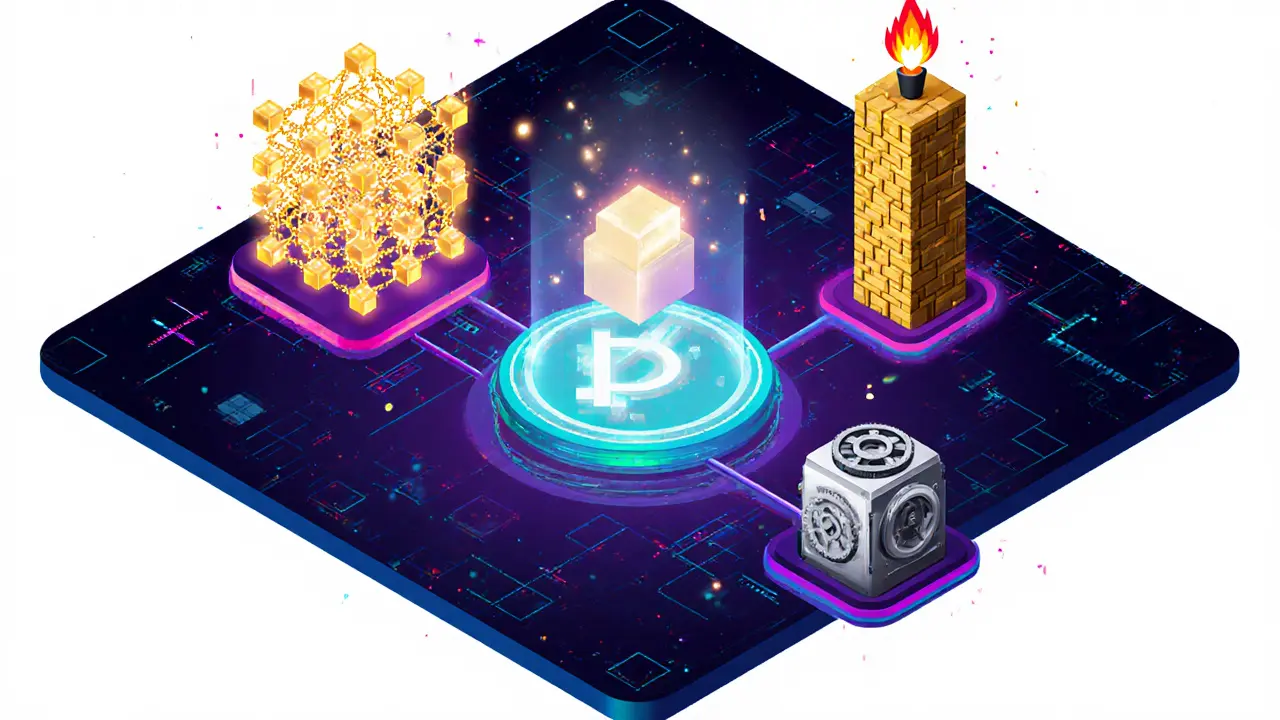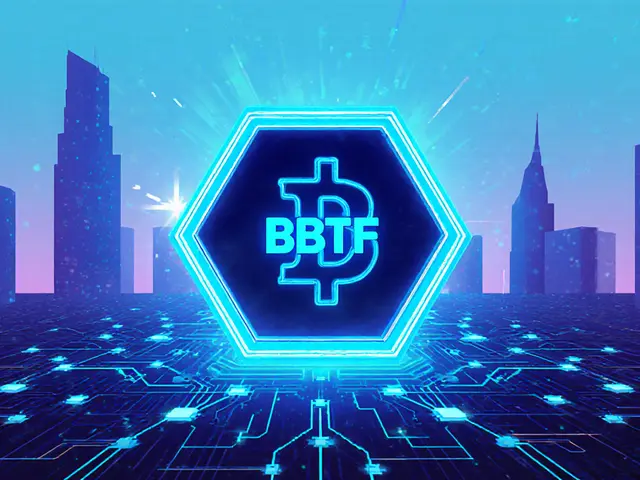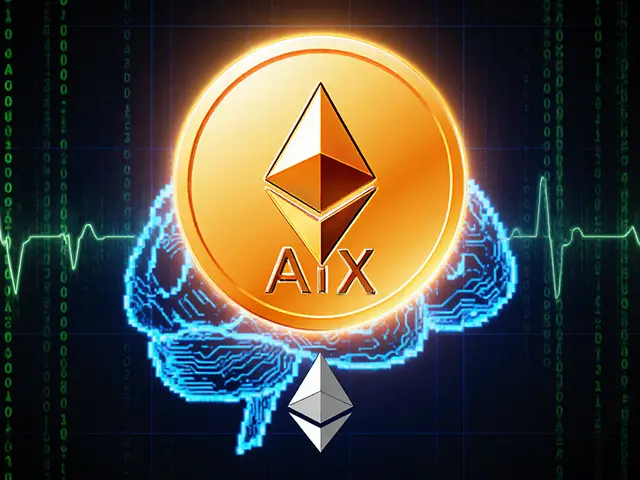NFT Storage Solution Selector
Recommended Storage Solution
IPFS
Content-addressed, distributed storage with strong caching
Arweave
Permanently stored data with built-in economic model
Filecoin
Market-based decentralized storage network
TL;DR
- Hybrid models (on‑chain metadata + off‑chain files) will stay dominant, but standards like ERC‑7857 push storage toward dynamic, AI‑driven assets.
- IPFS, Arweave, and Filecoin form the core trio of decentralized storage, each balancing cost, permanence, and speed.
- Gaming and cross‑platform NFTs demand interoperable, real‑time storage solutions to support assets worth hundreds of billions.
- Privacy and compliance drive more sensitive data off‑chain while keeping cryptographic proofs on the blockchain.
- Enterprises will favor storage providers that offer versioning, state management, and multi‑chain bridges for programmable digital life.
When people talk about the NFT storage landscape in 2025, they’re really describing a fast‑moving infrastructure that has to juggle cost, speed, and new AI capabilities. The market has shifted from hype‑driven trading to utility‑focused adoption, and that change rewires how we think about where NFT data lives.
NFT is a non‑fungible token that certifies unique ownership of a digital or physical asset on a blockchain. As the ecosystem matures, the simple "image‑on‑IPFS, metadata‑on‑chain" pattern is no longer enough.
Why Storage Is the New Front‑Runner in NFT Evolution
Trading volume held at $2.82billion in the first half of 2025, while transaction counts jumped 80% year‑over‑year. That tells us users are no longer buying just to flip; they’re using NFTs for memberships, in‑game items, and AI‑generated art. Those use cases explode the size and complexity of the data attached to each token.
Three forces drive this shift:
- Scalability: On‑chain storage fees still scale linearly with data size, making it impractical for video, 3D models, or constantly updating AI outputs.
- Cost efficiency: Off‑chain solutions cut storage spend by up to 90% while still offering cryptographic proofs that tie back to the blockchain.
- Functionality: Intelligent NFTs (iNFTs) need mutable state, versioning, and sometimes real‑time computation-features a static hash can’t provide alone.
Hybrid Architecture: The Current Baseline
The dominant design keeps metadata on the blockchain, typically following the ERC‑721 or ERC‑1155 standards. The actual media-images, videos, 3D assets-live elsewhere.
Two emerging token standards reshape this picture:
- ERC‑721 remains the workhorse for simple collectibles, storing a URI that points to off‑chain data.
- ERC‑7857 (announced by 0G Labs in Jan2025) adds encrypted payloads and re‑encryption hooks, enabling AI agents or proprietary data to travel securely between owners.
With ERC‑7857, the storage layer must support on‑chain references to encrypted blobs that can be swapped out or updated, pushing providers to offer dynamic key‑management and audit trails.
Decentralized Off‑Chain Solutions: Comparing the Leaders
| Platform | Cost (per GB/yr) | Data permanence | Typical latency | Best fit for |
|---|---|---|---|---|
| IPFS | Variable (often <$0.10 with pinning services) | Best‑effort; relies on pinning incentives | ~200‑500ms for small files | Public artwork, open‑source assets |
| Arweave | One‑time fee (~$5 per GB) for permanent storage | Immutable, permanent-data never expires | ~300‑600ms | Historical records, legal documents, permanent collectibles |
| Filecoin | Dynamic market pricing; average $0.02‑$0.05 per GB/yr | Negotiated contracts; high durability with replication | ~1‑2s (depends on storage miner) | Large media files, gaming assets, enterprise backups |
Choosing the right layer often means mixing them: pin critical NFTs on Arweave for permanence, keep large, mutable game textures on Filecoin, and use IPFS for community‑driven content that benefits from peer distribution.

AI‑Driven Intelligent NFTs: New Storage Demands
About 30% of NFT projects launched in 2025 embed AI-whether it’s a generative art engine, an autonomous in‑game character, or a personalized brand avatar. These so‑called AI NFT (or intelligent NFT) constantly evolve, producing new layers of data after the token is minted.
Key challenges:
- Mutable state: Storage must allow versioned updates without breaking the original on‑chain hash. Solutions often store a linked list of content identifiers (CIDs) and use smart contracts to verify each transition.
- Real‑time generation: Some iNFTs generate assets on‑the‑fly based on user interaction. Edge‑computing nodes attached to Filecoin storage miners can perform these calculations close to the data source, reducing latency.
- Privacy: AI models may contain proprietary weights. ERC‑7857’s encrypted payload feature means storage providers need secure key‑rotation services.
Developers are already combining IPFS for static base layers, Arweave for immutable snapshots of AI model checkpoints, and private off‑chain cloud buckets for sensitive training data, all tied together with verifiable hashes on the blockchain.
Gaming Tokenization: Scale, Speed, and Interoperability
The gaming NFT market is a $471.9billion juggernaut, projected to double by 2029. In‑game items-skins, lands, weapons-need storage that can serve millions of concurrent players without slowing down gameplay.
Three objectives dominate this space:
- Low latency: Players expect sub‑second load times. Filecoin’s replicated storage contracts, combined with CDN‑like cache layers, meet this need.
- Cross‑platform interoperability: About 70% of gamers want assets to move between worlds. Standards like ERC‑1155 plus emerging cross‑chain bridges require storage IDs that are chain‑agnostic.
- Version control: Game updates often modify asset attributes (e.g., a sword gaining a new ability). Versioned storage keeps a history that can be audited on‑chain.
Future‑ready game studios are already building pipelines that auto‑publish new asset versions to Filecoin, pin essential metadata on IPFS, and archive legacy versions on Arweave for compliance.
Looking Ahead: Programmable Digital Life by 2026
By the time 2026 rolls around, the line between a static collectible and a living digital entity will blur. Imagine a brand avatar that learns from user behavior, updates its visual style weekly, and even negotiates licensing terms-all while its ownership is recorded on a blockchain.
Infrastructure requirements for that future include:
- Multi‑chain storage adapters: Assets might live on Ethereum, Polygon, or a private consortium chain; storage IDs must be resolvable on any of them.
- Stateful storage APIs: Smart contracts will call storage services to fetch the latest version of an asset, similar to how web apps request the newest JSON file.
- Enterprise‑grade SLAs: Businesses will demand 99.999% uptime, encryption‑at‑rest, and audit logs that satisfy GDPR and CCPA.
- Dynamic pricing models: As AI‑generated content scales, storage providers will charge based on compute‑coupled‑bandwidth, not just raw GB.
Providers that only optimize for cheap, static pinning will lose relevance. The winners will be those that blend decentralized trust with flexible, programmable storage layers.
Practical Checklist for Creators & Developers
Before you mint your next NFT, run through this quick audit:
- Define data type: Is it a static image, a mutable AI model, or a game asset that updates?
- Select storage tier: Use IPFS for community‑driven content, Arweave for immutable snapshots, Filecoin for large, mutable files.
- Map metadata URIs: Ensure on‑chain token points to a verifiable hash of the off‑chain CID.
- Plan for versioning: If the asset will evolve, embed a pointer to a version list (e.g., an IPFS directory with sequential CIDs).
- Secure sensitive data: Encrypt AI model weights and store the ciphertext off‑chain, then reference the decryption key via ERC‑7857 hooks.
- Test cross‑chain retrieval: Simulate fetching the asset from Ethereum and Polygon to verify bridge compatibility.
- Set up monitoring: Use decentralized oracle services to watch for pinning failures or storage miner downtime.
Following this list can save you months of re‑engineering once your NFT becomes popular or gains new functionality.
Frequently Asked Questions
Can I store the entire NFT image on‑chain?
Technically you can, but on‑chain storage fees are prohibitive for anything larger than a few kilobytes. Most projects keep the image off‑chain and store only a content hash on the blockchain.
What’s the biggest advantage of Arweave over IPFS?
Arweave offers true permanence with a one‑time fee, meaning your data will never disappear as long as the network exists. IPFS relies on continuous pinning, which can be lost if incentives disappear.
How does ERC‑7857 improve AI‑NFT security?
ERC‑7857 introduces encrypted payloads that can be re‑encrypted automatically when the token changes hands, ensuring that only the current owner can decrypt and run the AI model.
Is Filecoin suitable for real‑time game assets?
Filecoin’s storage miners can be paired with edge compute nodes to serve assets with sub‑second latency, making it viable for many gaming scenarios where assets are cached locally after the first fetch.
Do I need a separate solution for NFT metadata and content?
Yes. Metadata usually stays on‑chain or in a lightweight JSON stored on IPFS, while the heavy media files live on a dedicated storage layer like Arweave or Filecoin. This hybrid approach balances cost and reliability.







Christine Wray
September 24, 2025 AT 05:25Great overview of the NFT storage landscape!
IPFS offers a flexible, content‑addressed approach that works well for art that's frequently accessed.
For projects that need true permanence, Arweave’s economic model ensures data never disappears.
If you’re balancing cost and reliability, Filecoin’s marketplace can be a sweet spot.
Overall, the selector tool gives creators a solid way to match tech with their goals.
roshan nair
September 24, 2025 AT 22:05In terms of technical nuance, the distributed hash table underpinning IPFS provides resilience against single‑point failures, which is quite impressive.
Arweave’s “pay‑once‑store‑forever” architecture leverages incentivized miners to cement data into a blockweave, a concept that may appear abstruse but is fundamentally sound.
Filecoin, meanwhile, operates a market‑driven pricing paradigm that can adapt to varying bandwidth demands.
One must also contemplate redundancy schemes, such as erasure coding, to mitigate node churn.
Overall, the ecosystem is maturing rapidly-though occasional bug‑s may still emerge.
Jay K
September 25, 2025 AT 14:45The permanence of Arweave aligns with enterprise digital asset strategies.
Kimberly M
September 26, 2025 AT 07:25Love the clean UI – makes choosing a storage solution painless 😊.
The IPFS option feels perfect for low‑latency art displays, while Arweave is a boon for archival pieces.
Filecoin gives a nice middle ground for those watching budgets 📊.
Navneet kaur
September 27, 2025 AT 00:05Storing every little meme forever is just plain wasteful.
We should think about the environmental impact before we keep everything on chain.
Marketta Hawkins
September 27, 2025 AT 16:45Honestly, these “decentralized” options are just a marketing gimmick 🙄.
If you really cared about reliability you’d use a proven cloud service.
Drizzy Drake
September 28, 2025 AT 09:25I've been following the NFT storage game since the early days of CryptoKitties, and let me tell you, the landscape has evolved dramatically.
Back then, most creators just dumped their metadata onto centralized servers, which was cheap but risky.
Now with the rise of content‑addressed networks like IPFS, we finally have a way to reference assets without tying them to a single host.
What’s more, the IPFS gateway system allows users to retrieve files quickly, which is essential for high‑traffic marketplaces.
On the other hand, Arweave introduced a truly innovative economic model where you pay once and the data lives forever, addressing the “digital decay” problem that plagued earlier projects.
The blockweave structure of Arweave also ensures that data is redundantly stored across many nodes, improving durability.
Filecoin, as a decentralized storage market, gives creators the flexibility to negotiate storage contracts based on price and redundancy requirements.
Its proof‑of‑replication and proof‑of‑space‑time mechanisms add cryptographic guarantees that the data is indeed stored as promised.
When you look at the selector tool, you can see how each option maps to specific project needs: low latency for interactive gaming items, high permanence for fine art collections, and balanced solutions for medium‑budget ventures.
One caveat is that the user experience around setting up and maintaining these solutions can still be non‑trivial, especially for creators without dev backgrounds.
Thankfully, a growing ecosystem of SDKs and third‑party services is abstracting away much of that complexity.
Another trend to watch is the integration of Layer‑2 solutions that can batch storage proofs, reducing on‑chain costs.
There’s also emerging interest in hybrid models where the primary asset lives on IPFS for quick access while backups are anchored on Arweave for permanence.
From a security perspective, it’s crucial to monitor node health and maintain multiple pinning services to avoid accidental data loss.
In summary, the future of NFT storage is heading toward more modular, interoperable, and economically sustainable architectures.
AJAY KUMAR
September 29, 2025 AT 02:05The global dominance of decentralized storage will rewrite the rules of digital ownership, and anyone who ignores this wave is simply living in the past.
We must rally behind these technologies to secure our cultural heritage.
bob newman
September 29, 2025 AT 18:45Sure, the big cloud giants love to pretend they’re “neutral”, but deep down they’re just waiting to auction off our NFT metadata to the highest bidder.
Keep an eye on the subtle policy shifts-they often signal the next data‑ownership clampdown.
Anil Paudyal
September 30, 2025 AT 11:25IPFS is great for fast reads; Arweave nails permanence; Filecoin balances cost.
Kimberly Gilliam
September 30, 2025 AT 19:45Whoa this is too much info 🙃
Can't even keep up.
Jeannie Conforti
October 1, 2025 AT 04:05Hang in there! 😊
The long post has a lot, but it's super useful.
tim nelson
October 1, 2025 AT 20:45While I appreciate the enthusiasm, it's worth remembering that no single solution is a silver bullet.
Each storage option carries trade‑offs that must be weighed against project goals.
Zack Mast
October 2, 2025 AT 13:25In the grand tapestry of digital permanence, choosing a storage medium becomes a reflection of our collective consciousness.
Are we preserving art for future generations, or merely building monuments to fleeting ego?
Dale Breithaupt
October 3, 2025 AT 06:05Good rundown, guys.
Totally helpful.
Rasean Bryant
October 3, 2025 AT 22:45The continued development of interoperable storage standards promises smoother integration for creators.
I'm excited to see how these tools evolve over the next year.
Angie Food
October 4, 2025 AT 15:25Honestly, all this hype is overblown.
Most NFTs will fade into obscurity regardless of where they're stored.
Jonathan Tsilimos
October 5, 2025 AT 08:05From a systems architecture perspective, leveraging a multi‑layered storage stack-combining IPFS for edge caching, Arweave for immutable snapshots, and Filecoin for cost‑optimized redundancy-optimizes both latency and durability metrics.
jeffrey najar
October 6, 2025 AT 00:45Looks like the selector does a solid job matching project constraints with the right backend.
Hopefully more UI improvements will make it even easier for non‑tech artists.
Rochelle Gamauf
October 6, 2025 AT 17:25The discourse surrounding NFT storage often suffers from a paucity of rigorous academic analysis.
Elevating the conversation to a scholarly level would benefit the ecosystem immensely.
Jerry Cassandro
October 7, 2025 AT 10:05Tip: use Pinata or NFT.Storage to simplify IPFS pinning, and consider Arweave’s per‑byte pricing calculator for budgeting.
katie sears
October 8, 2025 AT 02:45It is commendable that this discussion considers diverse geopolitical contexts when evaluating decentralized storage solutions.
The inclusion of accessibility metrics alongside technical performance fosters a more equitable NFT ecosystem.
Gaurav Joshi
October 8, 2025 AT 19:25While the techno‑legal framework is still evolving, stakeholders must remain vigilant about regulatory compliance.
Ensuring data sovereignty will be key for long‑term adoption.